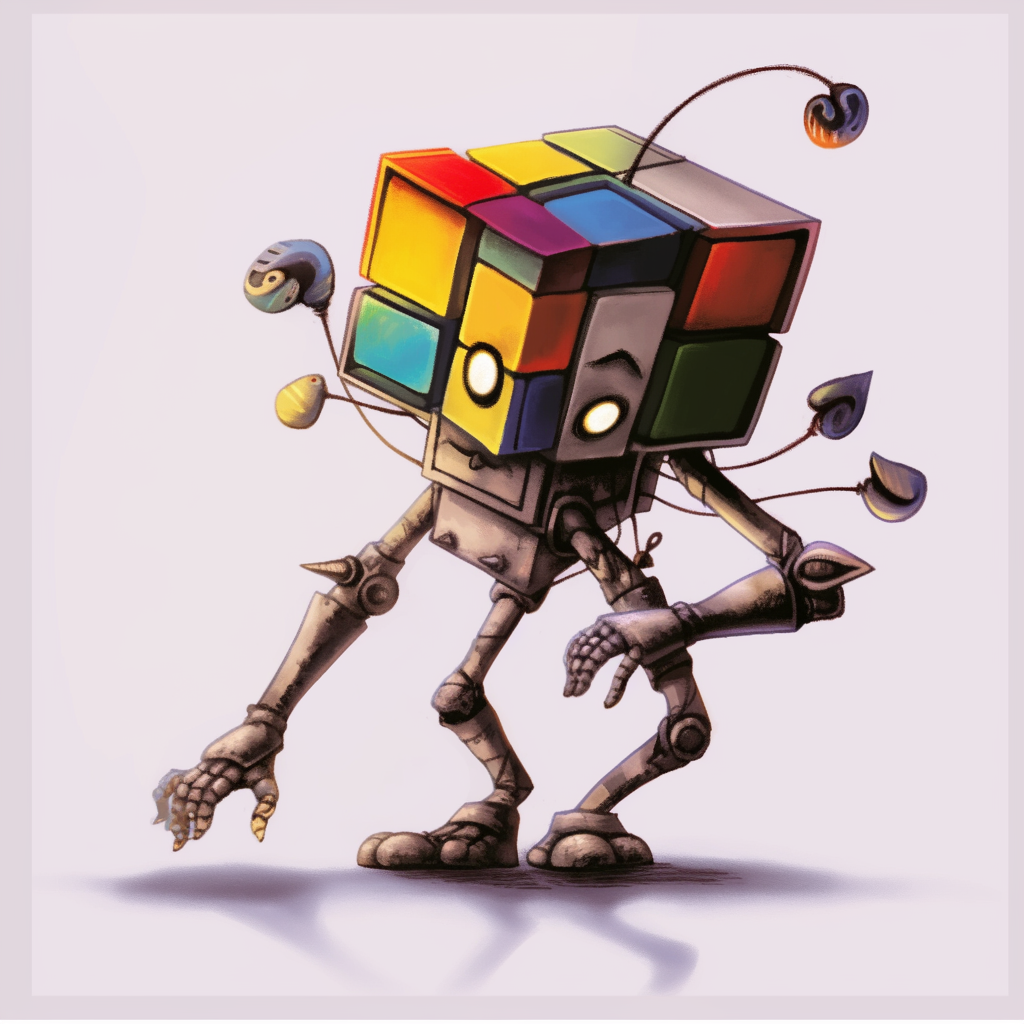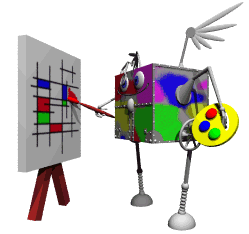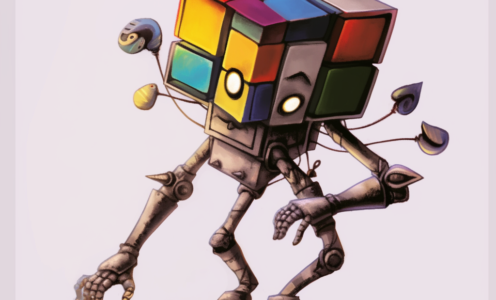Checker / Modrian
(Planar rogue modron wizard [they/them] Sensates / LG)
There are many mysteries in the multiverse—some big, most small. Among the most visible, if not the most strange, are the modrons. How did they come to be? What is their role in the multiverse? Why do they March? Among all of the questions associated with these beings, the most perplexing is how and why do certain of their numbers go rogue?
Each Rogue has a different story. Some receive conflicting orders; others simply snap when faced with the task of regulating the multiverse. In one case, a modron went rogue when faced with incontestable proof that the very laws it held dear were, in fact, barmy. This is the story of that rogue.

The artist commonly known as Checker is truly a rogue among rogue modrons. It is almost inconceivable that a being of utter law and order (even an outcast) would ever find a utilitarian purpose for things such as art and music. Yet, Checker has created one for itself. Through its creative endeavours, it is actually conducting research for a very unique life-quest. It is studying the nature of the multiverse, by determining what is real through experience. Not just its own, but everyone’s.
Being a creature of a mathematical nature, Checker knows and understands that a sample of size one does not provide any statistically valid results, so, it samples the reactions of a wide range of beings in order to find reactions to sensation which are common to all those beings. It does this by exposing a large number of subjects to the same, controlled stimulus – its art.
The reason for this study has its roots in the event which caused Checker to become the Rogue he is today. It was during the last Great Modron March, and the unit that was to become Checker had been separated from its fellows. Undeterred, it continued in its assigned task. During this time, the modron encountered a Xaositect artist. (While the name of this artist has been lost to time, his initials are still known—”M.S.E.”.) The Chaosman had been creating a series of drawings depicting architectural optical illusions. For a lark, the artist confronted the orderly being with these objects. Given the impossibility of the subjects, yet faced with physical proof of their existence, the rational mind of the modron unit began to give way. It repeatedly analysed the drawings and found no magic used to distort reality. It could also find no fault with the method by which the drawings were constructed; they obeyed all known laws of drawing.
The pieces of the paradox made sense by the laws, but the result did not. Faced with such conflicting sensations, the modron’s mind gearwork mind locked up and crashed trying to resolve the problem. No longer able to follow the modronic Ideal Law, the unit’s body of organic metal twisted and reformed, becoming the characteristic cuboid shape of a rogue. The newly created rogue then wandered off semi-randomly into the Outlands to try and find meaning to its new life and come to terms with the chaotic trauma it had suffered. Eventually, it decided that its own perceptions were at fault. Since it couldn’t trust its own senses, it would have to rely on the senses of others. Therefore it travelled to Sigil, joined up with the Sensates, and adopted the name ‘Checker’ to prove, to itself more than anything, that its new purpose was to check and verify all the Multiversal Laws it has assumed to be true.
“Wait! This unit has detected a shift
—Checker
in the local Multiversal Constant.
I must verify the affected Law.”
While seeming odd, this was actually a very logical choice. The Society of Sensation is dedicated to the study of experiences and holds a vast store of them in their Sensoriums. In fact, the Society was so pleased to have a rogue modron in its ranks, that Checker was quickly made the Head Librarian in charge of cataloguing and maintaining the vast store of experiences.
Soon, the modron sensed a problem with the experiences stored by the faction. Each event is recorded only once. To the modron, this is an error, as a tanar’ri would have a different reaction to fire than a water genasi. Realising this lack, it knew it could not find the common experiences if such crucial data was missing. It needed to find a method of exposing every type of being in existence to a common stimulus, and recording the results. Remembering the crisis which gave it ‘birth’, it came to a logical and orderly conclusion. Art is the most intense stimulus around (after all, if it can disrupt a modron, it can disrupt anything). Therefore, it would create art, and display it to beings in a controlled environment.
So Checker created its art studio. It has a wide range of visual stimuli (paintings) ready for experimentation, and has just recently begun to create auditory stimuli (songs). Once these are perfected, it will create stimuli for the other senses. (One can only cringe at the thought of modronic cooking.) Initially, the logical being was unable to create anything original; it was able to copy other works of art flawlessly, but could not even manage a still life without another image to copy. In time, Checker realised this limitation was due to the over-analysis to which even rogue modrons are prone. Unable to change his basic programming, the rogue created a subroutine of thought, which was more chaotic and less logical still (for a modron — this second personality still makes Factol Hashkar look like a Xaositect). This second persona was better able to create, and Checker called it “Modrian”.
While all this seems a terribly strange way to exist for the other Sensates, it’s entirely necessary for the rogue modron to keep its analysing logical personality and its (relatively) chaotic personality completely separate. See, allowing chaos into a machine-mind corrodes it rapidly, and were it not for these barriers, Checker would probably crumble into a haphazard heap of gears and springs.

The rogue modron is also dabbling in divination magic, particularly that concerned with ESP and perception, in order to better understand the minds of others. It’s said that Checker has become quite an accomplished mage, and its art (exhibited under the pseudonym of Modrian) has won critical acclaim from the Lazz school of Vivid Unpleasantness, and valuable contracts from the Fraternity of Order.
Despite these diversions, the modron’s primary goal is still it gallery, however. Concealed in the display stands for the stimuli are recorder stones ‘borrowed’ from the Festhall (presumably Checker knows a trick to preserve their magic once taken outside the Sensorium). When a new customer is exposed to a stimulus, the modron secretly records their feelings. At a later time, it analyses the results in order to build a common view of the stimulus. Using this data, it hopes to eventually construct a perfect sensory device. Once it has all five of its sensory organs perfected, it will take up its own Great March to check on what the Multiverse really is.
See also: The Common Sense
Source: Jon Winter-Holt and Ken Lipka, mimir.net. Old skool art by Jeremiah Golden, 1997. Very old school art inspiration by artist Piet Mondrian.

